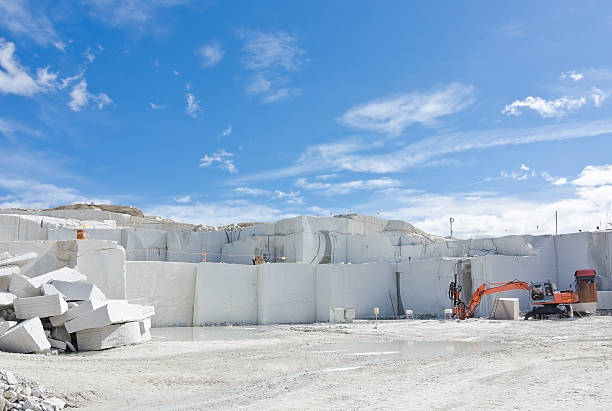Uncovering the Rich Background and Lasting Practices of Granite Quarrying
As we stand on the precipice of uncovering the complex tapestry of granite quarrying, a trip via time discloses not simply the physical act of drawing out rock however additionally the cultural and historical relevance woven into the really material of this technique. From the ancient beginnings that laid the structure for modern quarrying strategies to the sustainable practices that are shaping the future of this industry, each carve mark on granite surfaces narrates waiting to be uncovered (granite quarries in south africa). The heritage of granite quarrying extends far beyond simple extraction; it is a testament to human resourcefulness, strength, and the long-lasting appeal of this impressive rock
Old Origins of Granite Quarrying
Dating back to ancient people, the method of quarrying granite has actually been an essential component of human history and architectural improvement. The earliest proof of granite quarrying go back to ancient Egypt, where large pyramids and elaborate sculptures were crafted from this sturdy rock. The Egyptians made use of primitive tools to draw out granite blocks from quarries, showcasing the value of this material in their significant building and constructions.
Progressing in history, the Greeks additionally made substantial payments to the quarrying of granite. The Greeks utilized granite in different building marvels, such as holy places and statuaries, showing their skill in shaping and carving this durable stone. The Romans additionally fine-tuned the techniques of quarrying granite, utilizing sophisticated tools like blades and hammers to extract and shape granite for their legendary frameworks.
Through the centuries, the method of quarrying granite has actually evolved, with contemporary innovations improving effectiveness while preserving the ageless appeal of this natural rock - granite quarries in south africa. From ancient human beings to modern builders, the tradition of granite quarrying continues to shape our globe
Development of Quarrying Strategies
The evolution of quarrying strategies has actually been noted by a continuous progression towards greater effectiveness and accuracy in removing granite. Early quarrying strategies involved manual labor with basic tools such as chisels, hammers, and wedges to draw out granite blocks from the earth.
In more current times, the introduction of equipment transformed the quarrying sector, enabling much faster removal prices and boosted performance. Technologies such as diamond cord saws, high-pressure water jets, and pneumatically-driven drills have actually become conventional in contemporary quarries, permitting exact cutting and minimized waste. Moreover, improvements in computer-controlled equipment and 3D modeling have optimized quarrying procedures, leading to minimal environmental impact and boosted sustainability techniques. As the need for granite remains to increase, the development of quarrying techniques continues to be essential to conference market requires efficiently and sustainably.
Social Importance of Granite
Granite holds a profound cultural value across different civilizations as a result of its long-lasting presence in building work of arts and revered monoliths. From the impressive pyramids of Egypt to the elaborate makings of the Angkor Wat holy place in Cambodia, granite has been a material of choice for revealing majesty and longevity in cultural heritage. In ancient Rome, granite columns adorned holy places and public buildings, signifying stamina and durability. The cultural relevance of granite expands beyond its physical characteristics; it embodies durability, security, and eternity, making it an why not find out more icon of withstanding heritages and practices.

Lasting Practices in Quarrying
In the middle of the rich background of granite quarrying and its social importance exists an expanding emphasis on lasting techniques within the industry. As ecological recognition and concerns concerning source depletion have actually enhanced globally, the quarrying sector has increasingly embraced sustainable techniques to minimize its influence on the atmosphere and bordering communities.

In addition, improvement and rehab of quarry websites post-extraction are essential to sustainable methods. By bring back quarried areas to an all-natural or helpful state, such as creating wildlife environments or recreational areas, quarriers can balance out the environmental impact of their operations and contribute positively to the local environment.
Legacy of Granite Quarrying
With a historical background soaked in craftsmanship and industrial progression, what sustaining effect has granite quarrying left on the landscape of contemporary society? The heritage of granite quarrying transcends simple extraction practices; it has actually formed architectural marvels, city landscapes, and social heritage worldwide. The long lasting nature of granite has actually made it a preferred choice for monoliths, structures, my latest blog post and infrastructure, standing as a testament to the skill and virtuosity of quarry workers across generations.
Furthermore, the financial impact of granite quarrying can not be overlooked. The sector proceeds to offer work opportunities and drive local economies in areas where granite removal is common. It has also stimulated technological developments in quarrying strategies and tools, causing much more efficient and lasting practices.
In regards to sustainability, the tradition of granite quarrying consists of initiatives to reduce environmental influences with improvement tasks and responsible source administration. By balancing financial interests with environmental stewardship, the industry aims to guarantee that future generations can proceed to profit from this enduring natural deposit.
Verdict
